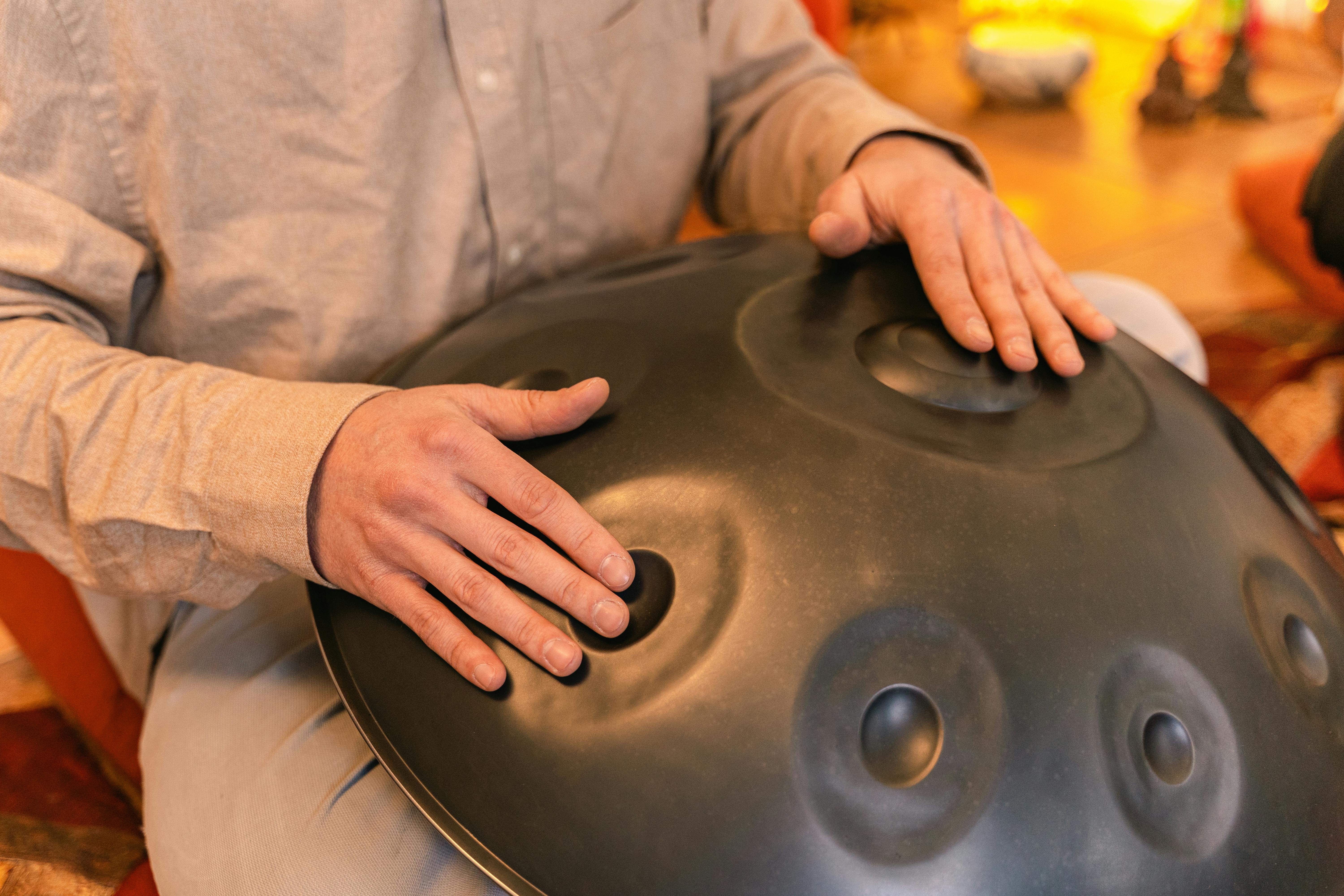 Hailed as the “Paganini of the Steelpan,” Liam Teague currently serves as the Head of Steelpan Studies and Associate Professor of Music at Northern Illinois University.
Hailed as the “Paganini of the Steelpan,” Liam Teague currently serves as the Head of Steelpan Studies and Associate Professor of Music at Northern Illinois University.
Along with Clifford Alexis, he co-directs the NIU Steelband.
His commitment to demonstrating the great musical possibilities of the steelpan has taken Teague to Europe, Asia, and Australia, as well as North and Central America and the Caribbean.
He has performed with many diverse ensembles, including Taiwan National Symphony, Czech National Symphony, Saint Louis Symphony, Panama National Symphony, Chicago Sinfonietta, Vermeer String Quartet, Dartmouth Wind Ensemble, University of Wisconsin-Madison Marching Band, Nexus, TCL Group Skiffle Bunch Steel Orchestra, BPtt Renegades Steelband and Starlift Steel Orchestra.
What made you want to be a musician?
Both my parents (Russell and Pearl Teague) loved music but were not musicians. I feel that music has always been in my DNA. My dad loved classical music and would constantly listen to it on the radio. Around the house he’d always be singing operatic arias and also introduced me to many symphonies, overtures, concerti e.g. Tchaikovsky and Beethoven violin concerti. This made me dream of being a Steelpan soloist with symphony orchestras. My mom always loved steelpan music and would religiously listen to steelband music- especially at Panorama time.
What drew you to the Steelpan as an instrument? My father had a cub scout troop when I was a boy and one of our members, Darren Shepperd (an excellent steelpan soloist and arranger), brought a Steelpan to one of our meetings. This is where I caught the “Pan Jumbie” and immediately asked my dad if I could join a Steelband. He consented and I joined the T&TEC Motown Steel Orchestra.
What drew you to classical music? Mainly my father’s influence. Also, through Mrs. Shirley James (then leader of the Trinidad and Tobago National Youth Orchestra), I was able to take violin lessons as a youngster. This played an integral part in shaping my musical development.
How do you feel about being called a child prodigy? I never considered myself to be a child prodigy, as I started music relatively late (around 11 or 12). However, I did develop at a very quick rate and won my first steelpan soloist competition at the age of 13.
What does that word mean to you? I suppose it refers to a child who demonstrates a great deal of talent not normally associated with someone of such tender years. In many instances, child prodigies may have an enormous amount of technical proficiency but can sometimes be lacking in the area of musicality, usually because they have not had a lot of life experience—though this is definitely not always the case.
Who are your biggest non-Pan musical influences? I listen to so many different styles of music and, as a result, I am influenced by many different musicians. From classical music composers and musicians, to jazz masters like Charlie Parker, John Coltrane, Chick Corea, Herbie Hancock, Joshua Redman, to great musicians in the world music genre (Indian music, Samba, Choro, etc).
Who are your biggest Pan influences? I am influenced by many musicians in the Steelpan world, famous and not famous. I think that my main influences early on as a player were Ken “Professor” Philmore, Len “Boogsie” Sharpe, Robert Greenidge, Ray Holman, Rudy “Two-Left” Smith, Andy Narell, etc. Jit Samaroo was probably my biggest influence in regard to steelband arranging. Now, I listen to many of my contemporaries, including Victor Provost, Leon “Foster” Thomas, Duvonne Stewart, and even to musicians much younger than I am – Andre White, Kareem Thompson, Freddy Harris III, to name a few.
Why? I consider all of them to be brilliant artistes who are taking the pan into interesting musical (and physical) avenues. They are not satisfied with adhering to the status quo.
What is your goal with the Steelpan as an instrument? To consistently highlight the steelpan’s beauty, versatily and profundity to the world. To create avenues for the up-and-coming generation of Steelpan musicians, so that their creativity can flourish and they can have long and rewarding careers doing what they love.
What are the primary obstacles preventing it from achieving that goal? The Pan, in many segments across the globe, is either not known, or if it is familiar, often is relegated to novelty status. There are some people who are not motivated to shine light on this instrument’s profundity, but prefer to use it as a way to make quick money and are fine with perpetuating negative stereotypes. While I cannot and will not ignore the fact that people need to put food on the table and, at times, may have to perform in less than ideal conditions, I cannot respect those whose ONLY aim is to prostitute the instrument. This, to me, exemplifies either a lack of knowledge of the pan’s history, or blatant disregard for the people who made so many sacrifices and literally had to shed blood, sweat and tears, so that the Steelpan could rise in such an astronomic fashion. This is one of the obstacles.
Another is that we in the steelband world can often be our own worst enemy. We demand that the general public give unequivocal support to the steelband, yet we don’t attend each others’ concerts, purchase CDs, accessories, music, etc., and are somehow surprised when the Panman’s plight remains unchanged. Instead, we prefer to engage in discourse that is filled with venom and laced with disrespect.
Another thing that can be unhealthy is our narrow-minded allegiances to a particular band, player or tuner. This type of mindset can often be an impediment towards growth. I feel that one of the solutions is for us to come together with a spirit of love and formulate plans that will reap dividends, not just for individual musicians or bands, but for the steelband movement as a whole.
Many of us need to let go of anachronistic and nostalgic thinking, and really focus on the future. This can take the form of creating new music for the steelband/Steelpan, fostering initiatives for our up and coming generation to be better musically educated, and to be more business savvy, amongst others.
How did you get hired by Silver Stars? The band’s arranger of many years, Mr. Edwin Pouchet, was not well for quite some time. He called and offered me the position. Of course, I jumped at the opportunity. Mr. Pouchet passed away on March 22nd, 2014, and I must offer my condolences to the family and friends of this wonderful human being.
How was your 2014 Panorama experience? It was fantastic. PCS Nitrogen Silver Stars is a class act, all the way!!! Very talented musicians and, most importantly, beautiful people. I believe that they were pleased with the arrangement and I loved how it was executed. This was one of THE most amazing musical experiences of my life!
What do you see for the future of Panorama and what is currently preventing it from achieving that goal? I love the event that is Panorama: the atmosphere, the diversity of the music and the general camaraderie that is exhibited in the panyards between players and supporters. However, it is no secret that I am not an advocate of Panorama, as a competition. Bela Bartok, the Hungarian composer, once remarked that “Competition is for horses, not for artistes”. While competition can be healthy and, if done right, promote development; it can often foster attitudes of ill will, disrespect, indifference and conformity. I see that happening a lot in Panorama, and a huge reason behind that is because it is a competition, not a celebration of music where people pay respect and reverence to these beautiful pieces of art. As a result, many arrangers (certainly not all, and I can’t emphasize this enough), prefer to adhere to the status quo. These are usually because they are trying to create music that they believe will meet the nod of the adjudicators and win the competition, and by extension, guarantee them job security. I can certainly understand their reluctance to deviate from using certain devices that have become the norm and, in some cases, have earned them and their respective bands “success”. The old adage “If it ain’t broke, why fix it?” seems appropriate here. However, I don’t think that this bodes well for the future of the music and art form. I have tried to create arrangements which simultaneously pay homage to tradition and genuflect to innovation.
Do you think Panorama should be seen as its own event or should promote more styles of music, such as Andy Narell’s jazzy approach with Birdsong in 2013 and 2014 (The Last Word, We Kinda Music)?
While I have tremendous respect for Andy Narell’s work (not just in Panorama), there are other arrangers who have created beautiful and intriguing pieces of art in Panorama that have not received the type of publicity that he has. Unfortunately, many people are not motivated to seek these musicians and their work out. As I have said on many occasions, Panorama arrangements need to be assimilated, analyzed and appreciated, well after the event is concluded. Just like music students reverently absorb the vocabulary of Beethoven, Mozart, Charlie Parker and John Coltrane, in conservatories and universities across the globe, so too should our pannists and the general public investigate the brilliance of our steelband arrangers and ensembles. The arrangements also need to be documented for posterity and educational purposes.
How can Pan truly be considered a musical instrument that lives on the same level as the piano or guitar and not as a novelty? The pan is considered a novelty by some, not by all. The majority of stakeholders have been progressive minded. This instrument has grown in such an astronomic fashion and just needs to be better marketed. It is probably one of THE most versatile and beautiful instruments in the world.
What advice do you have for the professional Steel Pannist looking to progress the instrument rather than continue its novelty “island” status? Study your craft. Immerse yourself into the history of the instrument. Do not settle for the status quo. Bring something new to the table. Believe in the power of the Steelpan—people’s jaws still drop in disbelief when they witness this amazing instrument, especially when it is played well. Be a musical chameleon. Never forget to pay homage to the people of Trinidad and Tobago. The sky is the limit.
Learn more about Liam Teague at his website: http://liamteague.com







